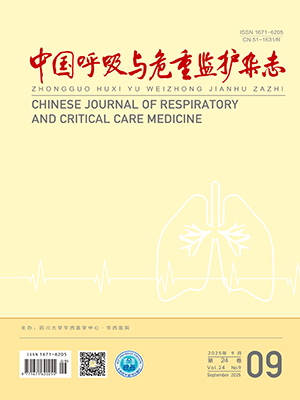Objective To investigate the protective effects of recombinant human insulin-like growth factor-1 ( rhIGF-1) on apoptosis of diaphragm in rats with COPD and its impact on pulmonary function. Methods Forty-five male Wistar rats were randomly divided into three groups, ie. a normal control group, a model group, and an IGF-1 intervention group, with 15 rats in each group. The rats in the model group and IGF-1 group were exposed to 5% smoke ( 30 min perday, lasting 28 days) in a sealed box, and 200 μg lipopolysaccharide was injected intratracheally on the 1st and 14th day. The rats in the IGF-1 group were given rhIGF-1 ( 60 μg /100 g) additionally by subcutaneous injection once a day, lasting 28 days. On the 1st, 14th, 28th day, 5 rats from each group were sacrificed. The weight, rate of apoptosis, Fas gene and Fas protein expression of isolated diaphragms were detected. The pulmonary function was measured on the 28th day before sacrificed. Results The mass of diaphragms, minute ventilation ( VE) , peak expiratory flow ( PEF) , inspiratory capacity ( IC) , forced expiratory volume in 0. 3 second ( FEV0. 3) of themodel groupand IGF-1 group were all decreased compared with the control group ( P lt; 0. 05) . The mass of diaphragms, VE, IC of the IGF-1 group were higher than those of the model group ( P lt;0. 05) , and the differences of PEF and FEV0. 3 were not significant ( P gt; 0. 05) . On the 14th, 28th day, rate of apoptosis, Fas gene and protein expressions in the IGF-1 group were lower than those in the model group, and still higher than those in the control group ( P lt; 0. 05) . Conclusions Fas/FasL mediated apoptosis way is involved in the diaphragm apoptosis. rhIGF-1 may reduce the apoptosis of the diaphragmand improve the VE and IC of rats with COPD by intervening Fas/FasL pathway.
Citation: SUN Lihua,OUYANG Xiaoping,GU Wei,TAN Yan,GAO Jingpeng. Effects of Insulin-Like Growth Factor-1 on Apoptosis of Diaphgramatic Muscle Cell and Pulmonary Function in Rats with COPD. Chinese Journal of Respiratory and Critical Care Medicine, 2009, 09(5): 441-445. doi: Copy
Copyright © the editorial department of Chinese Journal of Respiratory and Critical Care Medicine of West China Medical Publisher. All rights reserved




